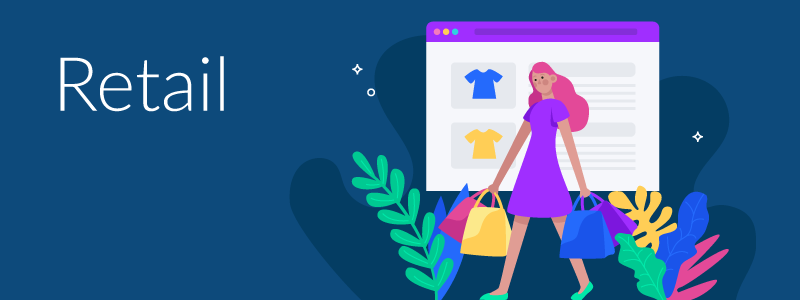
89% of companies have omnichannel retailing strategies in place, have you?
If you’re new to the concept, this guide will help you learn what omnichannel retailing is and what online and offline marketing strategies include. We will explore the core concepts and components you should add to make it effective. We will also discuss brands that use omnichannel retailing strategies well.
After reading, you will know how to combine omnichannel retailing with offline marketing strategies. Let’s begin with the basics.
What Is Omnichannel Retailing?
Omnichannel retailing is a marketing strategy to make the shopping transition smoother. Consumers browse the products online and then pick them up at the store. This transition lets you deliver a consistent on-brand experience and messaging throughout the customer journey.
Consumers can also enjoy omnichannel retailing benefits. They can switch between channels and shop with ease. Since the data are in sync, consumers can access the same product, pricing, and inventory information. They can also choose the most convenient way to fulfill their orders or return/exchange their purchased items.
Omnichannel Retail vs. Multichannel Retail
Some confuse omnichannel with multichannel retail. While similar, multichannel retail sells through different channels that operate independently. This means each sales channel has different inventory and promotions to offer. Let’s cover the differences between omnichannel and multichannel retail in detail.
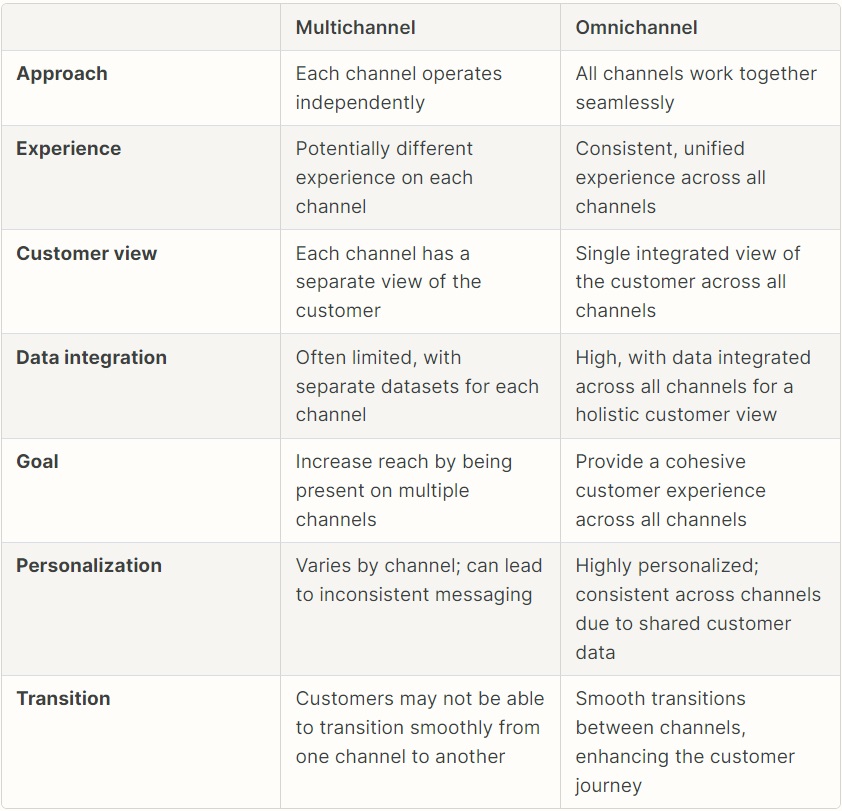
How Does Omnichannel Retailing Work?
One simple way to understand how omnichannel retailing works is to see its connection to the customer journey. Its process fits every step of how a customer buys a product.
It starts with the awareness stage, where shoppers browse for a product they need or want. As they look around, they will see your brand as one potential option.
When they narrow down their options, they enter the consideration stage—comparing products, prices, and more. They collect as much information as they need to make a decision. Consumers find this stage the most challenging because there are so many options, and it overwhelms them.
An excellent solution to make it easy is providing them with clear and concise information. Features, return policies, promotions, and perks are good information to pique their interest.
- Payment method: Credit cards, digital wallets, or bank transfers
- Customer self-service support: Live chat, help centers, or chatbots
- Delivery options: In-store pickup, same-day delivery, or standard shipping
Make sure to include your sales channels. Once they decide to buy your product, they can go straight to your store, website, or mobile app. All your channels collect data at every step of the process. This includes mobile app usage, purchase history, and other interactions with your brand. Use them to personalize your communications and recommendations.
Best Practices: Create An Omnichannel Retailing Map
Creating an omnichannel retailing map helps you identify which aspects work well and what needs fixing. When making the map, understand the critical stages of the customer journey. Cover everything—from first hearing about the product to interactions after buying it.
You should also know the channels where your customers interact with your brand. Here’s an example of an omnichannel retail map.
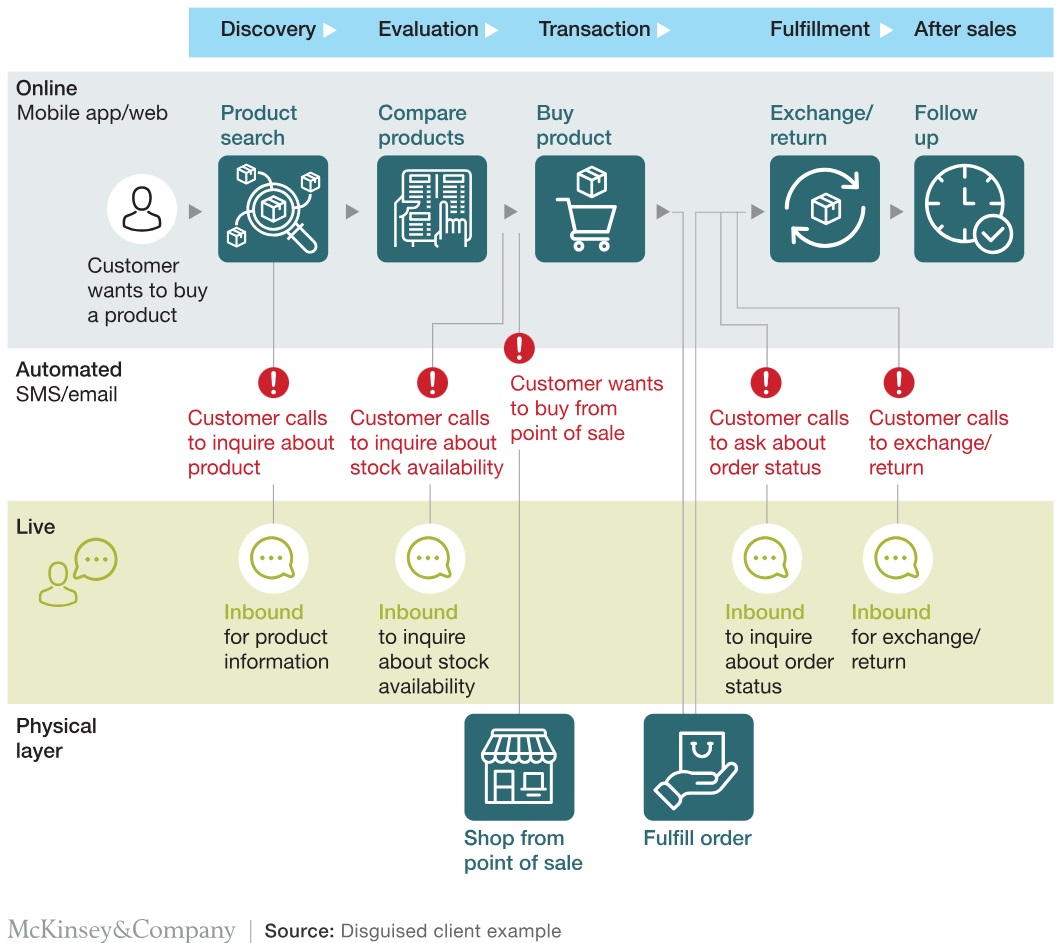
8 Examples Of Effective Omnichannel Retail Strategies
Let’s consider 8 brands that use effective omnichannel strategies and see how each omnichannel strategy works and get these results.
1. Netflix Omnichannel Hyper-Personalization
Hyper-personalization is an omnichannel strategy that ensures brands deliver relevant and meaningful customer interactions. It uses real-time behavioral data and advanced algorithms to make the omnichannel customer experience more unique.
Netflix is one of the brands that successfully implemented this strategy. Its streaming platform collects data to customize its recommendation engine for each subscriber. Netflix equips itself with different AI technologies to analyze and process data. These are the data it processes:
- Access and device information
- Other subscribers with similar tastes and preferences
- Movie information (title, genre, category, release year, etc.)
- Content interaction history (including ratings and viewing patterns)
Netflix’s recommendation system starts when a subscriber creates a new account. It will ask a few questions to determine the best viewing experience to deliver on their homepage. One question it asks is, ‘Will there be any children watching?’ If the subscriber chooses yes, then Netflix will show programs with child-friendly titles.
It will also present several movies the subscriber can choose from. Whatever they pick, Netflix will base its recommendation on it.
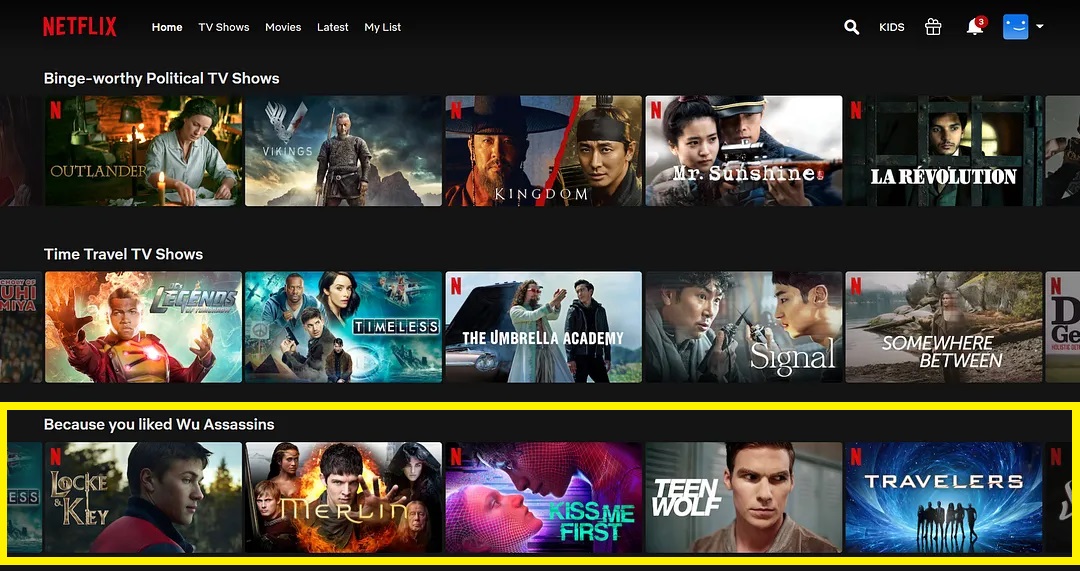
This step is optional. If the subscriber skips the step, it will give the subscriber a diverse and popular set of films and programs as a starting point.
Key Takeaway: Use Data Collection & Analysis Tools
Hyper-personalization revolves around data. Use reliable data collection and analysis tools, such as Tableau, to get accurate and relevant data.

Tableau provides a simple process for transforming data into actionable insights. It also presents insights in charts, maps, and diagrams for quick analysis.
2. Simply Beach Social Commerce Integration
Social media platforms’ popularity remains high, with 26% of users saying they use them to shop. So, adding social commerce integration is a must. Social commerce integration lets customers discover, share, and buy products straight from the brand’s social media platforms. Make sure to pinpoint the platforms where your customers are most active to drive success.
Simply Beach, a women’s swimwear and beachwear shop, optimizes its social profiles and content to integrate well with social commerce. Let’s consider their Instagram account.
Optimized Elements | Expected Results |
|---|---|
Adding product tags | Boost sales because customers can discover and purchase products fast |
User-generated content | Create a solid community that encourages customer engagement and interaction |
High-quality product images and engaging videos | Provide customers with an in-depth look at the products |
Clear and compelling product descriptions | With an accurate description, it helps customers make smart buying decisions |
Here’s how the brand implements these elements into its Instagram posts.
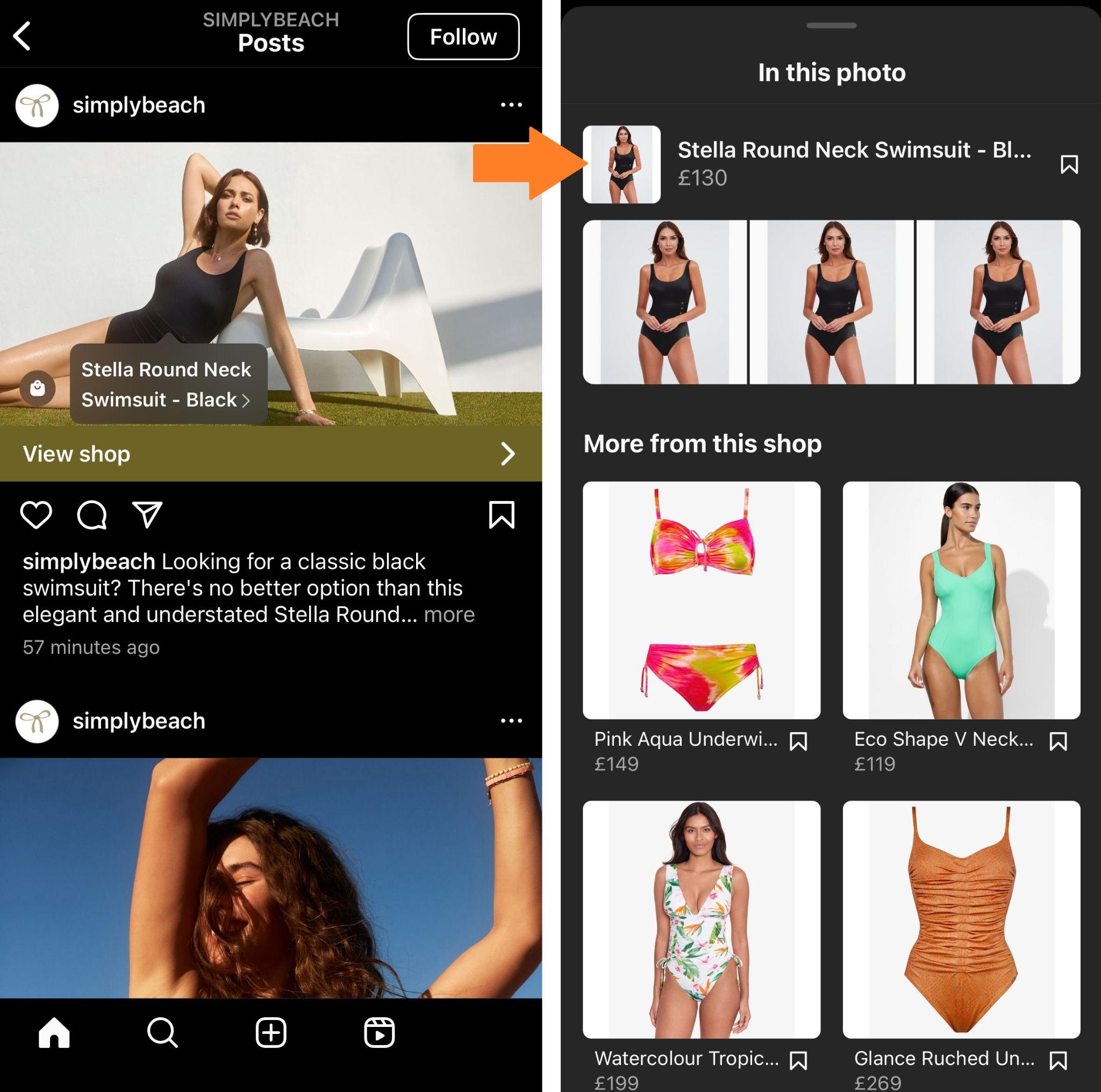
They also offer 2 payment methods to accommodate different customers’ preferences. The first option is for Shop Pay and Google Pay users: use the express checkout to complete the transaction. It’s fast and convenient. The second option is manually encoding your shipping details and credit card information.
Key Takeaway: Personalize Language & Tone
Social commerce makes it easier for consumers to discover your products, buy them, and share their experiences with others. An effective way to achieve this is by personalizing your message using your target audience’s language, tone, and style.
Let’s take Simply Beach, for example. Use friendly language and an inviting tone to make your customers feel valued. They also promote warmth and excitement, elements that are good for sharing the enjoyment of beach adventures.
You can also add words (e.g., sandy toes or sun-kissed) to promote relaxation and playfulness. This makes your message more fun and memorable.
3. Greenhouse Emporium Social Proof Integration
Nowadays, 97% of consumers expect to see positive reviews before buying a product. This proves that a brand only sells high-quality products and has a good reputation.
Greenhouse Emporium, a greenhouse kits and gardening supplies provider, knows how social proof impacts what people decide to buy. So, they make it easy for their customers to access social proof. They display the social proof at the bottom of their site’s page. No matter what product they look at, they can find the reviews whenever they want.
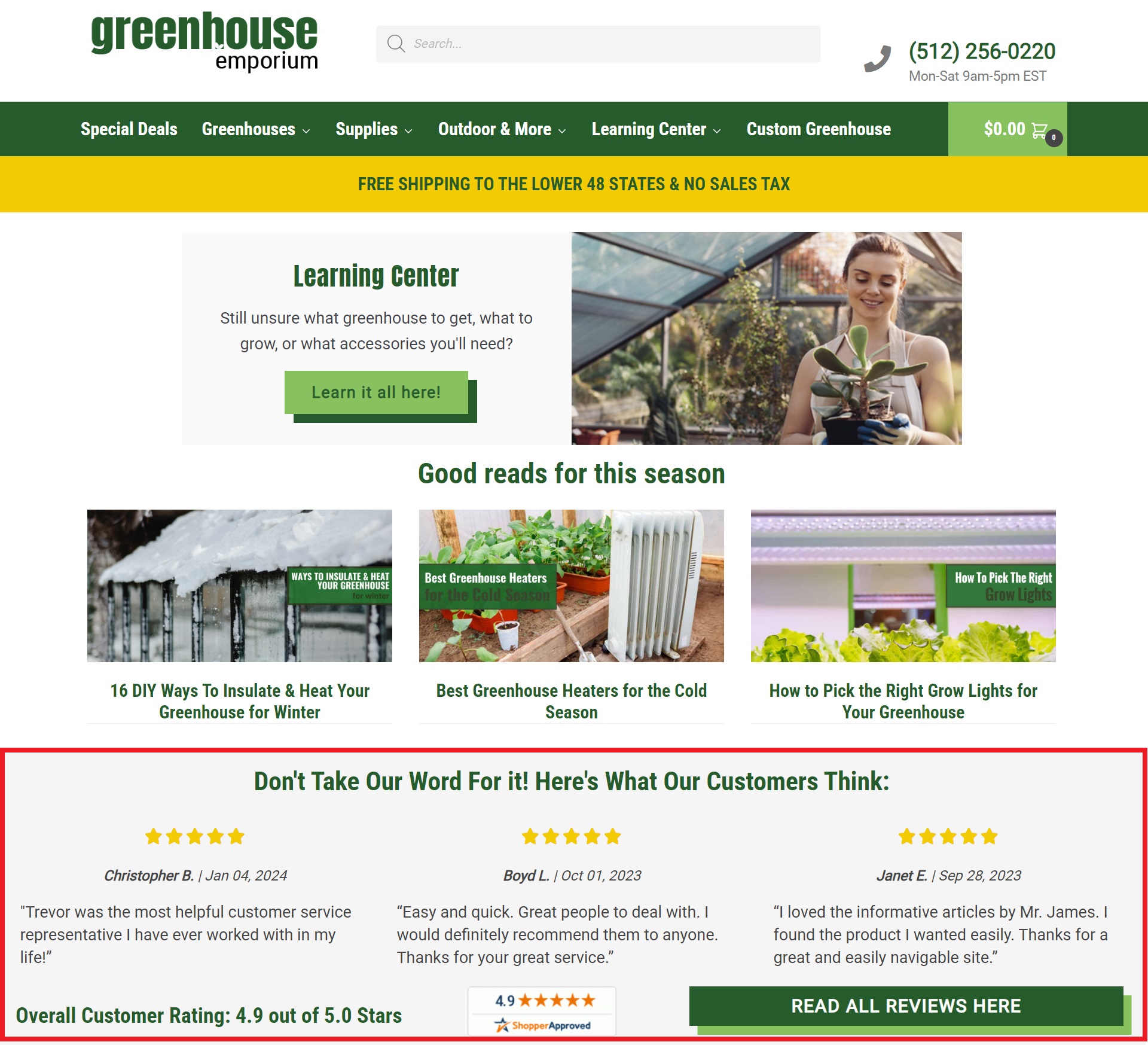
The visibility of social proof lies in its placement. To make it more visible, Greenhouse Emporium dedicates an entire page to customer reviews. They also place star ratings and review numbers on their greenhouse kits and gardening supplies catalog and each product page. Visitors can immediately see if previous customers recommend the product and how likely they are to buy again.
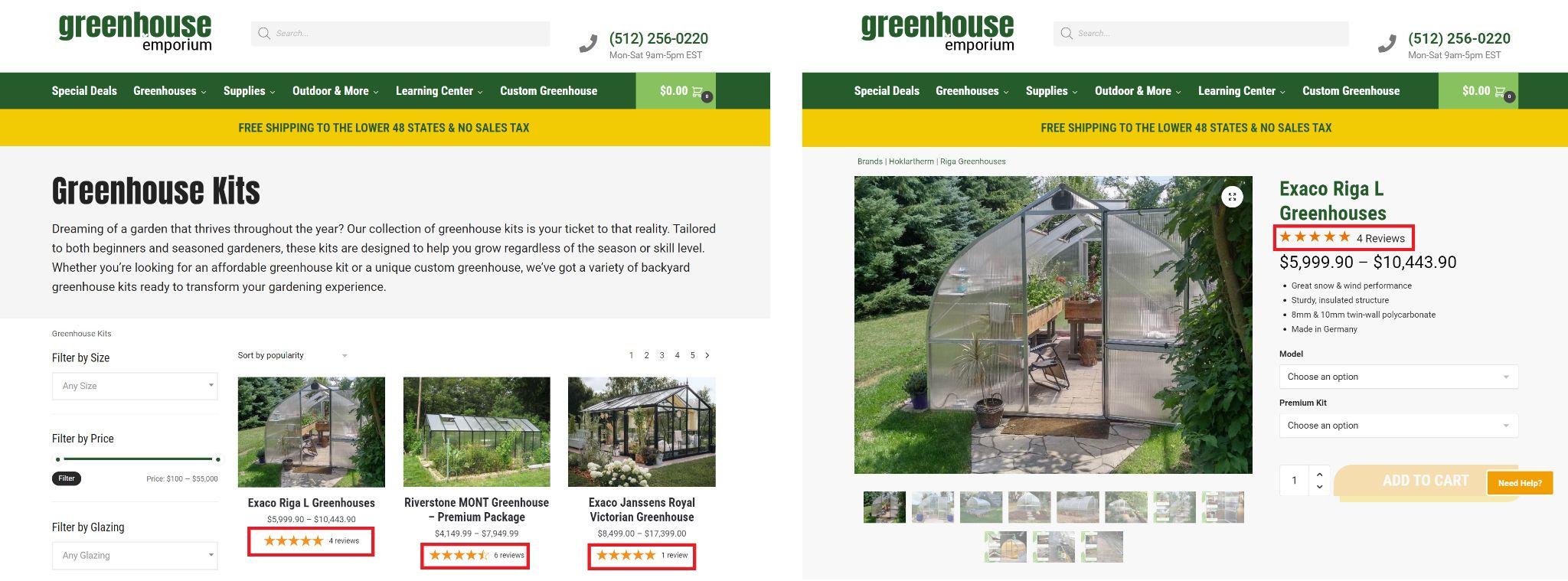
Key Takeaway: Verify Customer Review’s Authenticity
Fake reviews are rampant online, and detecting them is quite a challenge. Make sure to use a reliable system to identify suspicious reviews.
You can use a secure third-party review system like Shopper Approved. It’s Google’s official Product Review Partner that checks customer reviews fast. Its developers know consumers trust a brand more when it acknowledges its flaws and works hard to fix them. So, they made the system automatically publish all reviews, including the bad ones.
Greenhouse Emporium uses the same review system and never removes the negative reviews. It’s their way to show their commitment to transparency.
4. Shopify Seamless Return Process
Offering a consistent and hassle-free return experience saves customers time and effort. This is exactly what Shopify keeps in mind when they design 3 return options. They make sure that customers can make a return no matter what channels they use.
A. Online Request Form
This is the basic option sellers offer to their customers. When sellers receive the request, they can work on the return through their Shopify admin account or POS app.
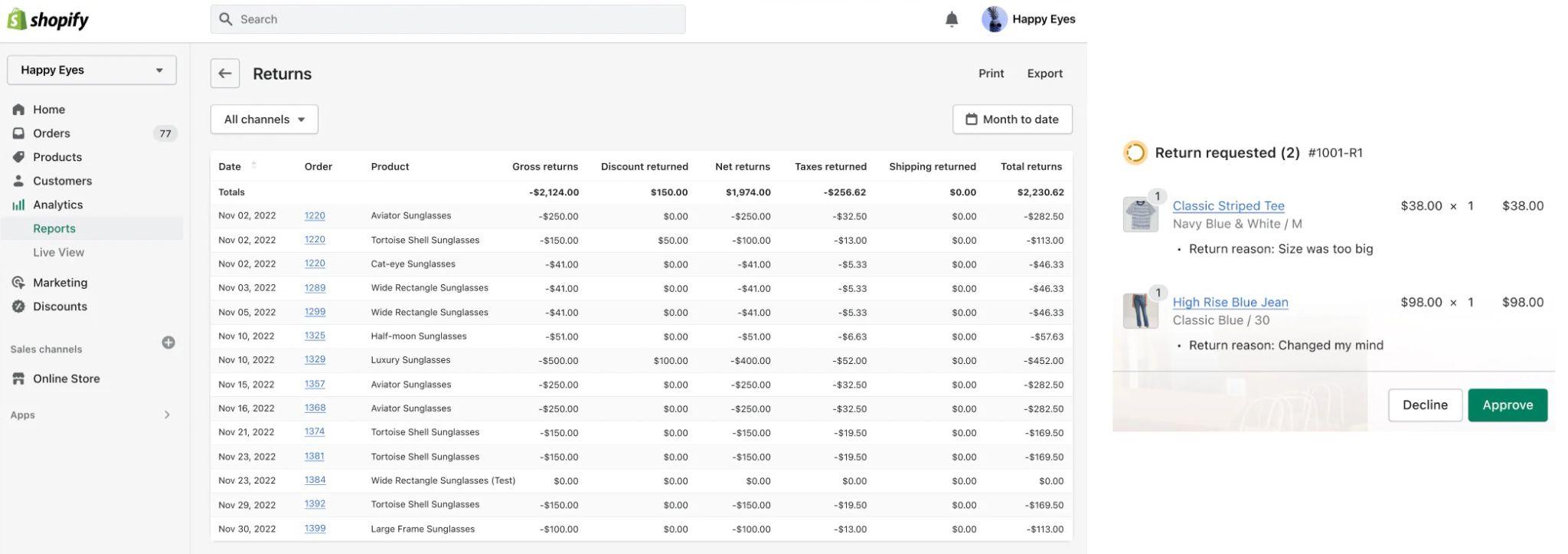
B. Self-Service Returns
Sellers also let their customers manage their returns through their accounts. They can request returns anytime without waiting for customer service help. After submitting the return request, the seller can approve or decline it.
Sellers can activate this feature on the Shopify admin account’s setting > customer accounts. Here’s how you can do it.
How To Use Shopify Self-Serve Returns – Shopify Tutorial

C. Social Media Platforms
Shopify offers sellers flexibility in selling and promoting their products, as well as in their customer service and return processes. They can explore Shopify’s extensive integrations to achieve their desired results.
One integration they offer is Return APIs. This can streamline return processes across multiple channels and give sellers a complete view of all return activities. It will also send email notifications to the seller when someone sends a new return request.
Key Takeaway: Provide Convenience, Consistency, & Transparency
The effectiveness of your return process is not based on how many channels you provide for customers to initiate return requests. It’s about how easy and convenient it is for customers to do it. Vinyl Status™ sets an excellent example because it keeps the return process simple.
Their return policies don’t have a long requirement list. If a customer finds damage or quality issues with their order, Vinyl Status™ will replace them. All customers need to do is submit the request form.
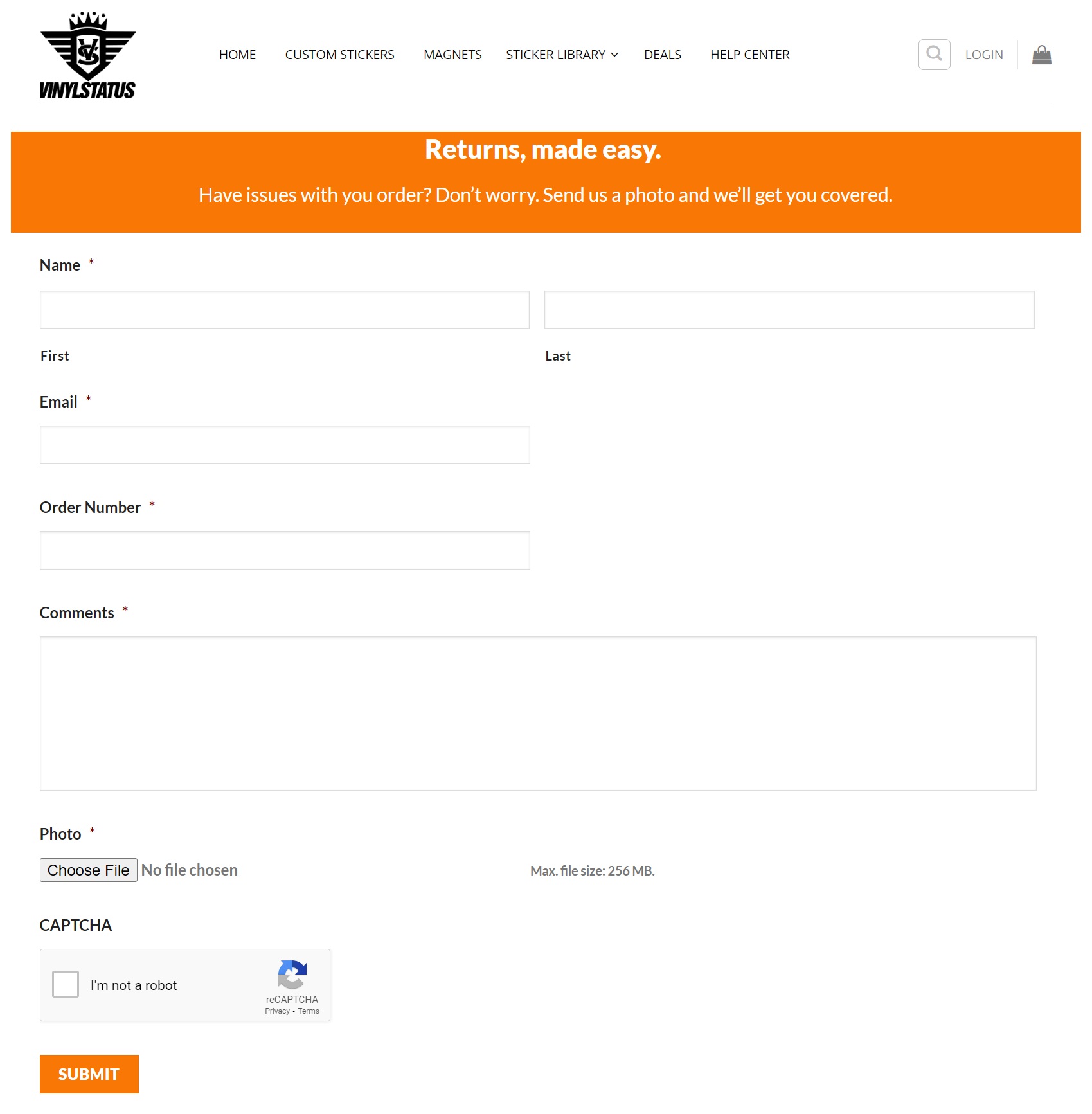
When submitting the form, Vinyl Status™ requires customers to include a photo. It helps them to assess the extent of the damage or quality issues.
Accepting returns encourages customers to return for more. However, dealing with returns of custom-made items can be tricky. Take Vinyl Status™’s collection of custom vinyl stickers, for example. Each printed vinyl sticker is made to fit the customer’s preference, making it hard to resell or reuse if returned.
Despite the challenges, Vinyl Status™ continues to prioritize customer satisfaction and offer hassle-free returns. If the final product doesn’t meet the customer’s expectations, the brand allots a 30-day window to return it.
5. Ovaeda Mobile Optimization
More people own mobile devices, and they many use them for online shopping. Mobile optimization is the process of adjusting your online store site to fit well on a mobile device’s screen size.
If you want to see how well mobile optimization works, you can explore this composite decking board website. Its web and mobile versions feature fast speed, responsiveness, and thumb-friendly navigation.
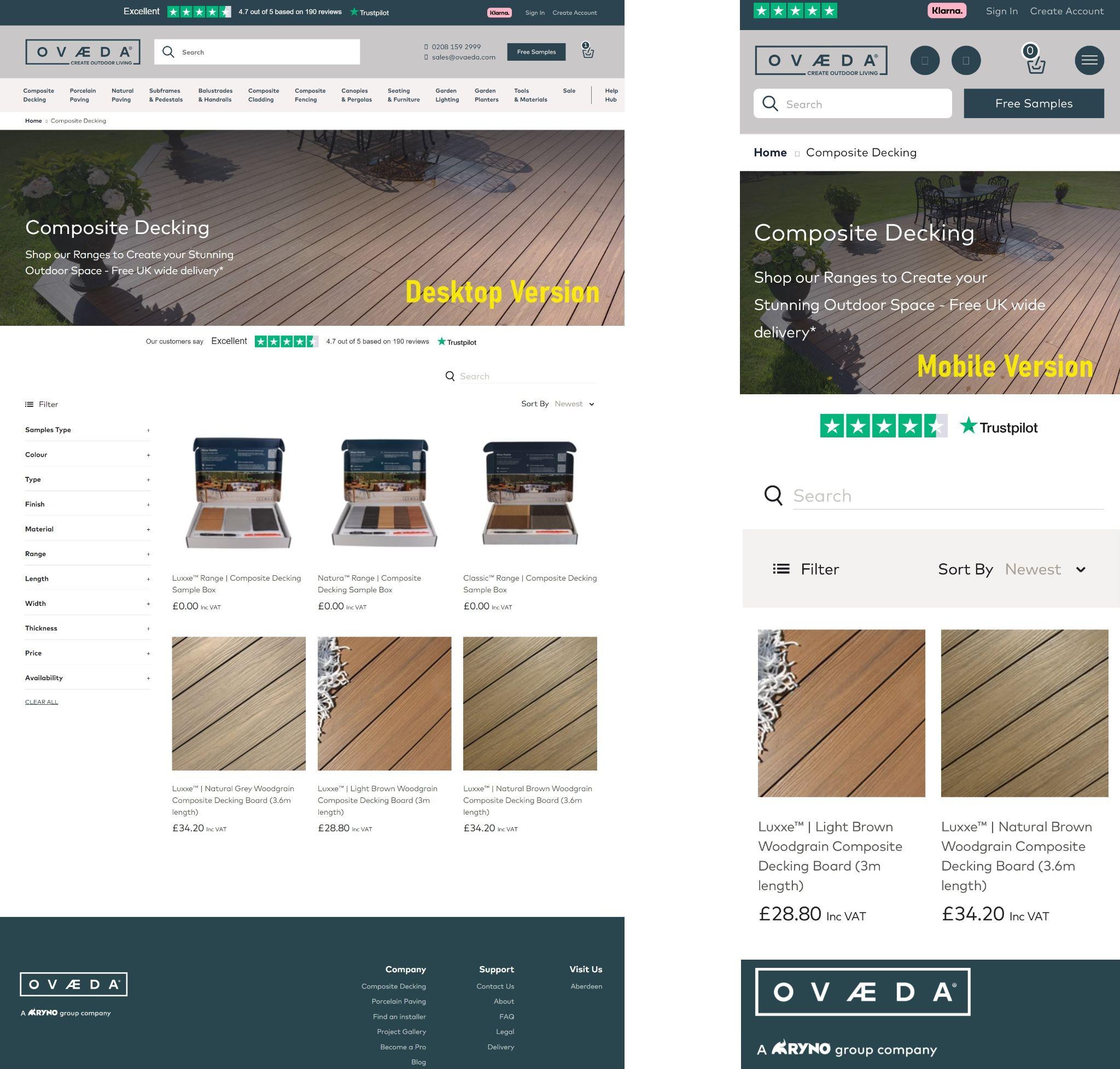
When you visit the Ovaeda website, its content loads quickly and flows smoothly between desktop and mobile devices. We tested it in Pingdom, and it shows a load time of 2.16 seconds–an acceptable score because the average site load time is 2.5 seconds on desktop (8.6 seconds on mobile).
Here are the elements that help the content load effortlessly.
- Readable text
- Consistent branding
- Relevant, high-quality images
The elements are appropriately sized and formatted for mobile screens. It also comes with a hamburger menu (3 horizontal bars), which helps make navigation easy. It makes the website neat and organized so customers can quickly find what they want.
Ovaeda uses short-form content to avoid excessive scrolling. They also design its checkout process with an express checkout option and a 3-step order form. Pay easily as they offer many mobile payment options like Google Pay and PayPal.
Key Takeaway: Test & Monitor Mobile App/Site’s Performance
Mobile optimization is an ongoing process. Make sure to monitor your mobile app or site regularly to see how it performs. It’s wise to set up alerts for critical issues like downtime or malware attacks. This helps you act fast and fix the issue.
You can use testing tools like Appium and Calabash to automate the process. Both tools are open-source, so you can design processes based on your testing preferences.
- Security
- Usability
- Functional
- Performance
- Compatibility
- User experience
6. Bariatric Fusion Loyalty Program
An omnichannel loyalty program is the strategy that helps bring customers back to your online or physical store. Most brands’ loyalty programs offer discounts for new shoppers or sign up for their email list. Bariatric Fusion includes its social channels to level up its game.
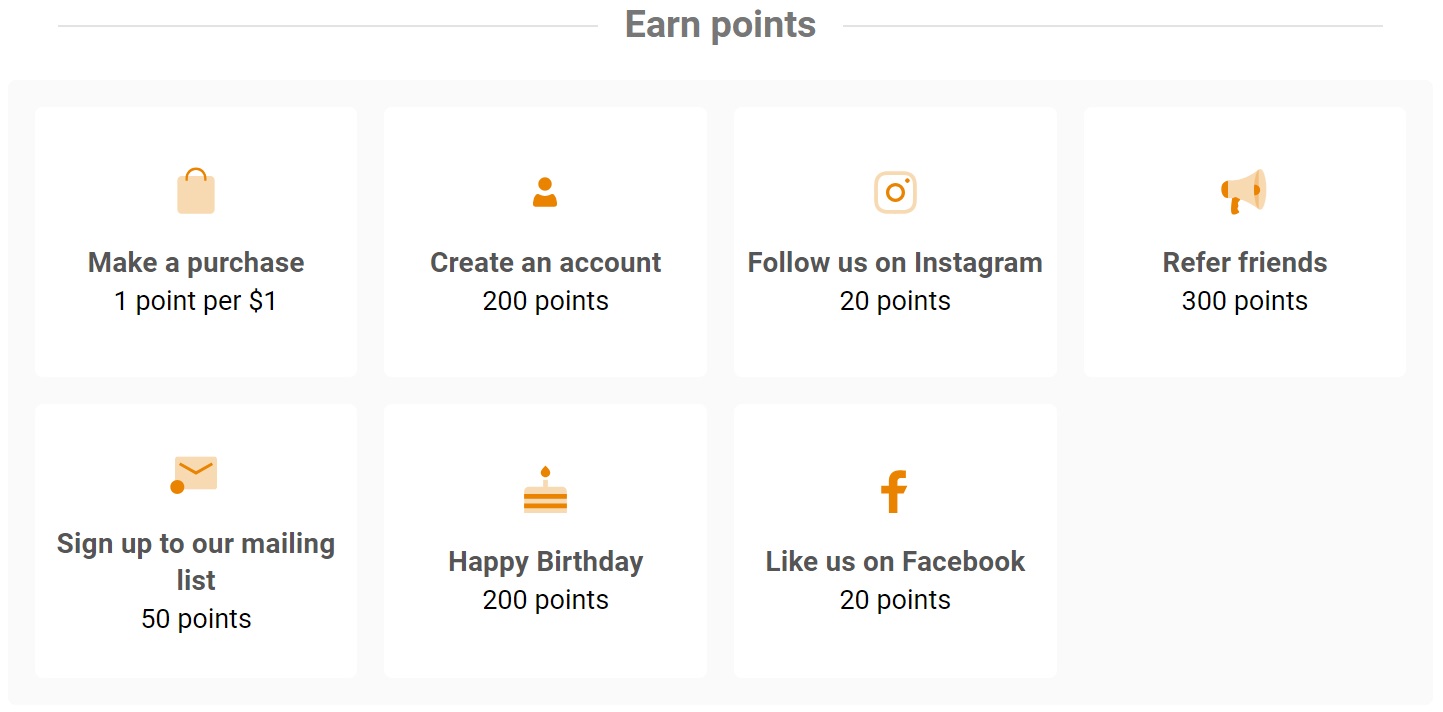
It encourages consumers to engage with the brand more. The best part of their point system is that there are no product restrictions. No matter what type of Bariatric multivitamins and supplements they buy, they will earn points ($1 = 1 point).
The brand knows that consumers appreciate businesses that provide unique offers, so it offers a variety of rewards. Once customers reach a specific number of points, they can redeem a discount, voucher, or free product.
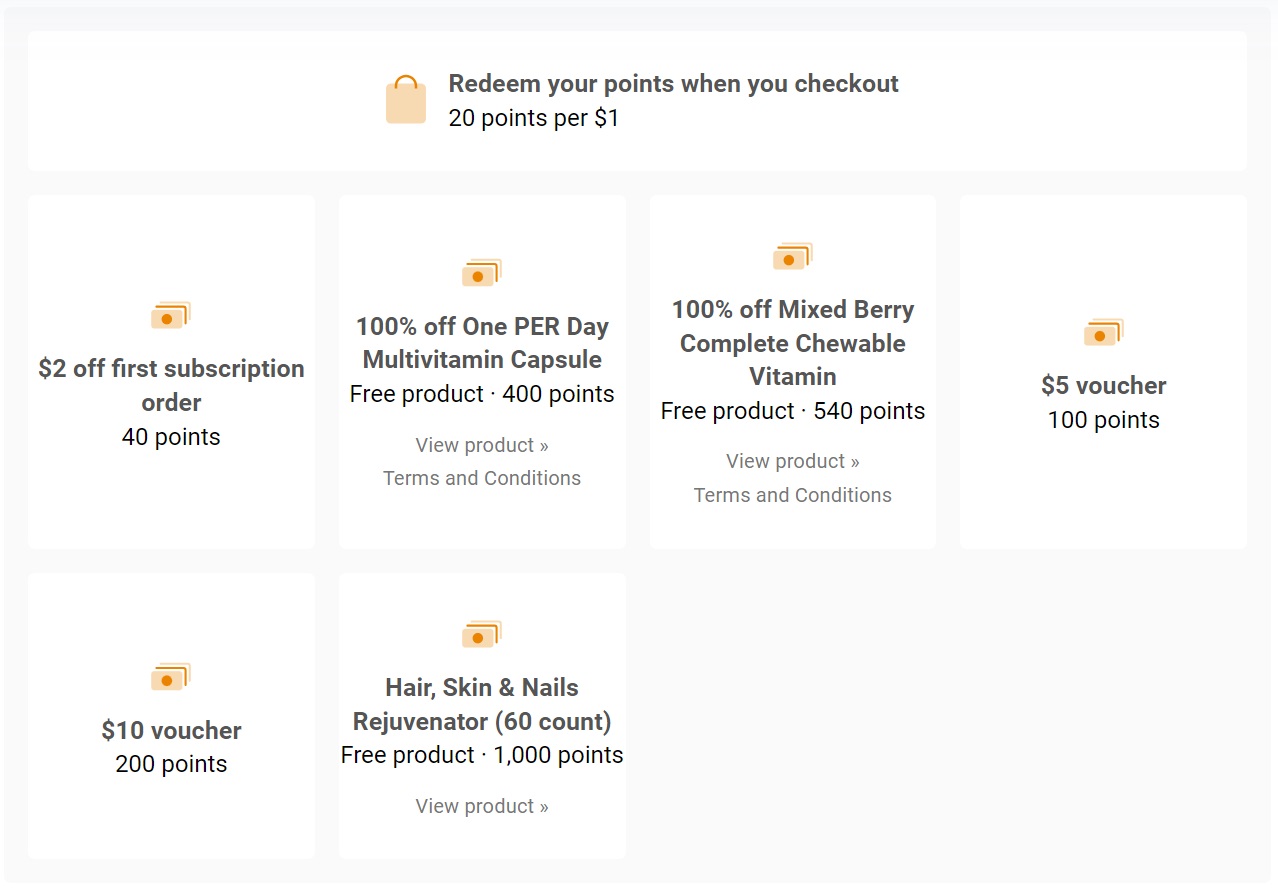
Key Takeaway: Communicate The Value Proposition
The goal of a loyalty program is to help customers save money. So, highlight the benefits and everything customers will get upon joining the loyalty program. Aside from what mentioned above, here are other promising incentives you can offer are:
- First-time shopper discounts
- Buy one, get one free (BOGO)
- Early access to new products or promotions
- Exclusive offers (e.g., downloadable digital assets)
Customers should also know everything about your loyalty program. Write the terms and conditions to describe:
- How it works
- Eligibility criteria
- Any limitations or restrictions
- How to earn and redeem rewards
7. Green Supply Customer Service Integration
A successful omnichannel retail strategy offers customers many useful choices (e.g., flexible payment, delivery, order tracking, etc.) throughout their shopping experience. You can also apply this strategy to your customer support. It assures customers that they will receive consistent support whenever and wherever they need it.
Green Supply established a strong reputation for providing quick and effective customer service support. This shows their dedication to addressing and resolving customer problems before they escalate. Currently, they provide 5 reliable communication channels.
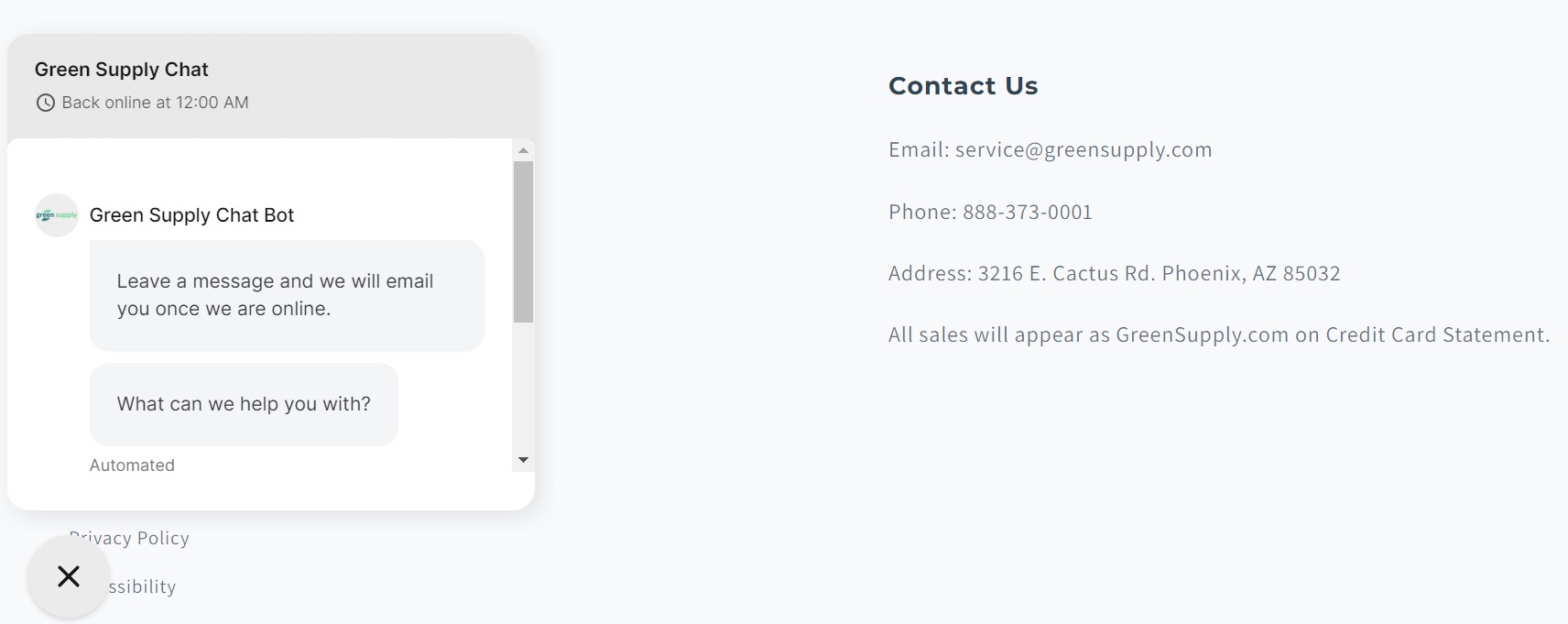
Communication channels serve different purposes. Use them correctly based on their strengths and the nature of the message. Here’s how to use each communication channel appropriately:
- Self-service options (FAQs): Address common questions and issues
- Email: Customer inquiries, quick updates, and support requests (returns, replacement, and refund)
- Phone and live chat (business hours): Escalate urgent issues, follow-up, and other real-time help
- Chatbot (offline): General inquiries and support requests (product information or order tracking)
- Social media messaging (Instagram): Inquire about promotions, address customer concerns, and fix issues
Key Takeaway: Improve Your Customer Service Response Time
Today, 32% of consumers expect customer service to respond within 30 minutes. To meet this expectation, you can implement the following solutions:
- Offer 24/7 support to accommodate service disruptions, technical issues, or urgent inquiries
- Set up a tiered support to organize incoming inquiries based on their urgency level or importance
- Create automated responses to handle general inquiries and route issues to the right support channels
8. 3Wishes Click-and-Collect Shipping
Delivery experience and speed have a huge impact on customers’ loyalty. This proves that fast delivery is no longer a perk; customers expect to get it every time. An excellent solution to deliver this need is click-and-collect shipping so customers can choose how they want to receive their orders.
This is a win-win strategy because customers will save money, while the retailer’s physical store boosts foot traffic. 3Wishes stands out as an excellent example of an efficient fulfillment process. They process orders quickly and have them ready for pickup within a short timeframe (same-day).
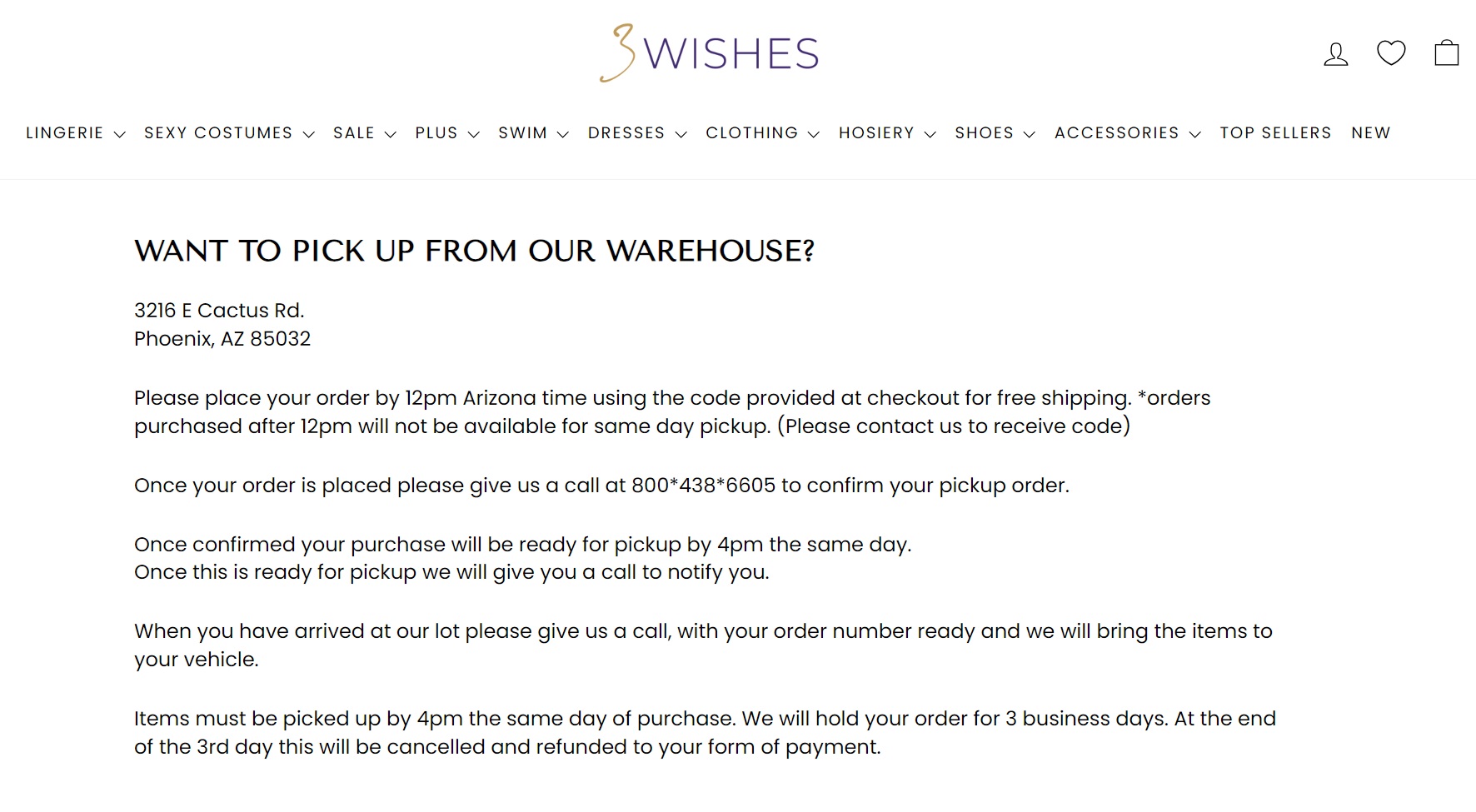
They provide their warehouse address and specific instructions on how to get same-day pickup. They also include their toll-free number so customers can confirm the pickup order. The brand is based in the U.S., so they provide different shipping options for locals.
Customers can get free same-day shipping if they place their order by 4 p.m. EST (Monday through Friday). They can also get free shipping for orders over $80. Other options come with a cost, depending on the length of time it takes to receive it.
When implementing this strategy, streamline your ordering process (sales channels and mobile apps). It makes it easier for customers to order on any desktop or mobile device. Here are other aspects of your process to develop well:
- Collect feedback: Use customers’ feedback to further improve this service
- Integrate with loyalty programs: Offer incentives to encourage repeat business
- Inventory management: Update inventory in real-time to prevent under- and overselling
- Promote the service: Spread awareness and highlight its benefits to attract more people
Key Takeaway: Provide A Convenient Pickup Experience
Click-and-collect shipping is much faster and more affordable compared to home delivery. To ensure you will provide consistent customer satisfaction, establish a dedicated pickup counter. Put a clear signage so that customers can locate it fast.
Effective communication is also vital to its success. You should also communicate with them about the pickup process so they know what to expect when they arrive. Provide instructions on what they should bring to claim their order.
3 Best Practices To Nail Omnichannel Marketing
Make shopping online simpler for your customers. Here are the best practices to help you achieve success in omnichannel retailing:
I. Understand Customer Behavior

The better you understand your target audience, the more you can personalize their shopping experience. Analyze their shopping behavior and discover what they want, expect, and common pain points. Also, what motivates or triggers them to buy?
Lastly, identify which channels they use the most and for what purposes (browsing, purchasing, or researching). Here are details you should consider when targeting consumers who prefer to shop in-store:
- Browsing habits
- Engagement with staff
- Aspects of the in-store experience they value the most
- Interactions with products (the time since they last engaged with the products)
II. Use Appropriate Tools
Getting the right tools accomplishes tasks quickly and efficiently. Manual inventory updating, for example, is time-consuming and tedious. But using Shopify listing software can make it simple.
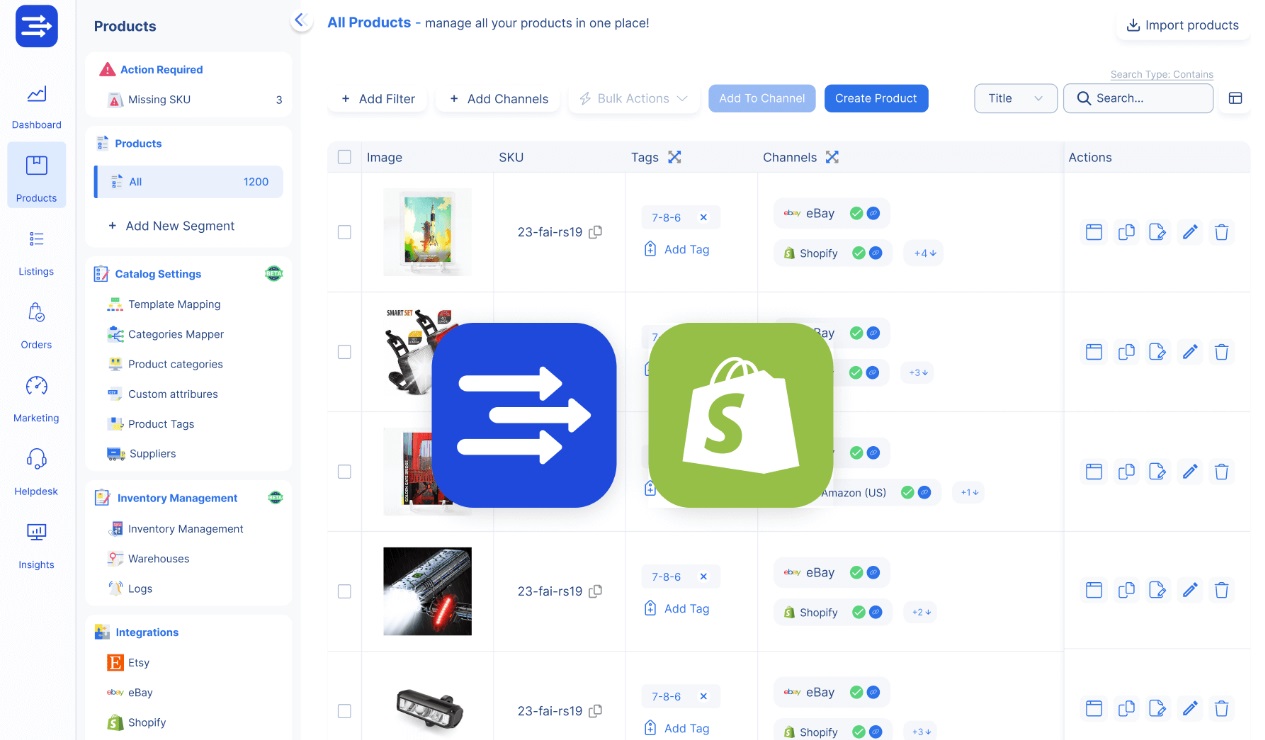
The first step is to link your Shopify account to EasyChannel. Then, you can easily import, publish, and maintain your listings in one place. Other popular tools you can use are the following:
- Social listening tools: Brandwatch, Digimind, or Sprout Social
- Point of Sale (POS) systems: Shopify, POS, Lightspeed, or Square
- Customer feedback form & survey builder: Jotform, SurveyMonkey, or Typeform
- Website or social media analytics: Google Analytics, Kissmetrics, or Semrush
- Customer relationship management (CRM): Salesforce, HubSpot CRM, or Sales Creatio
III. Keep Up With The Latest Omnichannel Retail Trends
Consumer behaviors and preferences are changing fast. Keep your business up-to-date to keep your brand relevant and competitive.
Google Trends is an excellent tool for keyword research. It helps you learn each search term’s popularity, seasonal patterns in search behavior, and more. Use these insights to improve your content planning and SEO strategy.
Statista is a better option if you want to access in-depth data for various locations (global or local regions).
Conclusion
With the tight competition in the retail industry and the rise of digital technology, relying on a single channel isn’t enough. To keep up, expand your business using various new channels. That’s where omnichannel retailing comes in handy.
Omnichannel retailing brings together all efficient ways for consumers to shop with ease. Doing it right will open more opportunities to make sales and build stronger relationships with your customers. To ensure you will succeed, make sure to:
- Design a seamless customer experience for all touchpoints
- Collect accurate and relevant customer data using your sales channels and mobile app’s analytics
Don’t have a mobile app yet? AppInstitute can help you get started. You can create your own mobile app with no coding skills required. Visit our website to learn more.
Author Bio:
Burkhard Berger is the founder of Novum™. He helps innovative B2B companies implement modern SEO strategies to scale their organic traffic to 1,000,000+ visitors per month. Curious about what your true traffic potential is?
- Author picture: Here
- Gravatar: [email protected]
0 thoughts on “What Is Omnichannel Retailing And How Does It Work? + Examples”